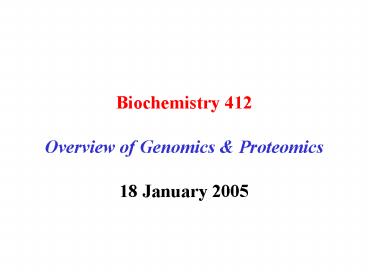Biochemistry 412 - PowerPoint PPT Presentation
1 / 22
Title:
Biochemistry 412
Description:
Biochemistry 412 Overview of Genomics & Proteomics 18 January 2005 DNA Sequencing & the Human Genome Project Timeline: The Foundations of Genomics 1953 Model for ... – PowerPoint PPT presentation
Number of Views:83
Avg rating:3.0/5.0
Title: Biochemistry 412
1
Biochemistry 412 Overview of Genomics
Proteomics 18 January 2005
2
(No Transcript)
3
(No Transcript)
4
DNA Sequencing the Human Genome Project
5
Timeline The Foundations of Genomics
1953 Model for 3D structure of DNA - J.
Watson F. Crick First protein sequence
(insulin) - F. Sanger 1965 First RNA sequences
- R. W. Holley colleagues F. Sanger
colleagues 1970 Restriction endonucleases
discovered - D. Nathans H. O. Smith 1972
First recombinant DNA molecule - P. Berg
colleagues 1975 Plus-minus method of DNA
sequencing - F. Sanger A. R. Coulson 1977
Chemical method of DNA sequencing - A. Maxam W.
Gilbert Dideoxy method of DNA sequencing - F.
Sanger A. R. Coulson First bioinformatics
software for DNA sequences - R. Staden 1978
Single-stranded phage vectors developed - J.
Messing colleagues 1980 Shotgun cloning
strategy for DNA sequencing - J. Messing
colleagues F. Sanger colleagues 1981 Random
shotgun cloning method developed - S.
Anderson 1985 Polymerase chain reaction (PCR)
method developed - K. Mullis 1986 Development
of first automated DNA sequencer - L. Hood
colleagues gtgtgt For the past 25 years, the size
of the largest genome sequenced (from FX174 to
human) has doubled approximately every 18 months!
6
Lander et al (2001) Nature 409, 860.
7
(No Transcript)
8
(No Transcript)
9
The Random Shotgun DNA Sequencing Strategy gtgtgt
Allows sequence information about a target
genome to be accumulated rapidly and in a
non-biased and semi-automatable fashion.
10
Random shotgun DNA Sequencing Fragmentation by
DNAase I digestion of target DNA in the presence
of Mn
Anderson (1981) Nucleic Acids Res. 9, 3015.
11
Random fragmentation yields clones covering the
target DNA region (in this case, a portion of the
human mitochondrial genome)
Coverage is reasonably complete and uniform
Most regions are sequenced more than once,
improving overall accuracy
Anderson (1981) Nucleic Acids Res. 9, 3015.
12
gtgtgt The recursive, identical steps involved in
random shotgun DNA sequencing allowed automation
of the sequencing process (even for very large
genomes).
Anderson (1981) Nucleic Acids Res. 9, 3015.
13
Lander et al (2001) Nature 409, 860.
14
Lander et al (2001) Nature 409, 860.
15
Lander et al (2001) Nature 409, 860.
16
Lander et al (2001) Nature 409, 860.
17
Venter et al (2001) Science 291, 1304.
18
Venter et al (2001) Science 291, 1304.
Note individual B is Craig Venter!!
19
Differences between the Public (Lander et al) and
Celera (Venter et al) Human Genome Sequencing
Efforts
Public Project Mapped BACs and YACs from the
genome first, then shotgun sequenced these (to
sort out where the repeats were) Started
earlier (1990) Initial (2001) draft not as
accurate as Celeras (see below) Finished
later (2003) Final draft more accurate than
Celeras Cost ca. 3 billion Celera
Project Shotgun sequenced entire human genome
in one go Used sequenced end pairs from
linking clones to address the repeat problem
(also used public project data) Started in the
late 90s Initial (2001) draft more accurate
than publics (see below) Quit working before
final draft was finished Cost ca. 300
million
20
Differences between the Public (Lander et al) and
Celera (Venter et al) Human Genome Sequencing
Efforts (footnotes from previous slide)
Celeras sequence, which was proprietary,
incorporated all of the public data, which was
available on the internet, so initially Celeras
genome sequence was more complete and accurate
than the public consortiums sequence (Duh!!).
At the time, this fact escaped most journalists
who reported on the competition with the public
consortiums effort, and the consortium
scientists did not help their cause by dumping on
Celeras data! Applied Biosystems (ABI,
Celeras parent company) more than recouped all
of its expenses by selling DNA sequencing
machines to -- among others -- the panicked
public sequencing consortium members (and also by
selling Celera stock to Wall Street). Some
observers have even suggested that the entire
Celera human genome sequencing effort was nothing
more than a Machiavellian marketing ploy by
ABI! gtgtgt Nevertheless, the race between the
public and private sectors delivered a high
quality finished human genome sequence to the
scientific community years earlier than would
have been the case without such a competition!
21
(No Transcript)
22
Lander et al (2001) Nature 409, 860.































